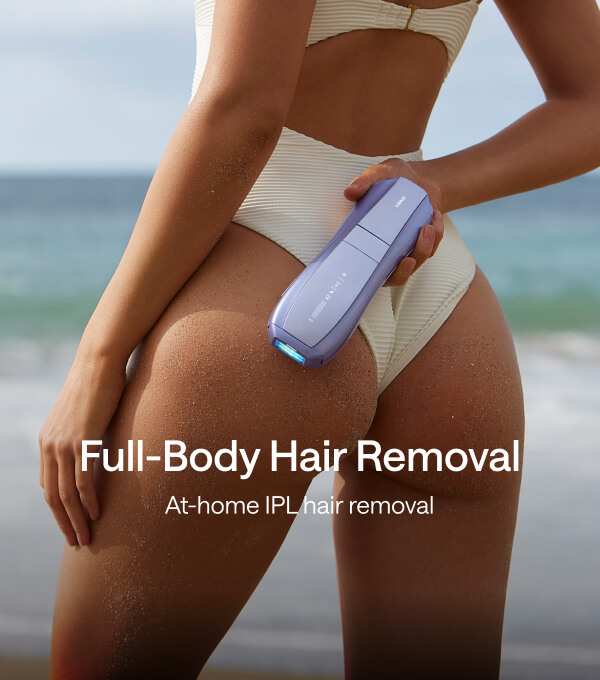When it comes to skincare routines, it is safe to say that there is no such thing as “one size fits all” and in this article, we will describe how you can build your own skincare routine from scratch that fits your skin needs.
SKINCARE ROUTINE AND ITS BENEFITS
Research shows that following
consistently
a daily skincare routine can have the most significant long-term impact on the overall quality of our skin complexion, helping restore and maintain our skin’s health and beauty over time [1]. For this, we simply need to select effective products that will cover the basic skincare needs (protection, prevention, cleansing, and moisturizing), according to our specific skin type and skin concern [1].
SKIN TYPE VS. SKIN CONCERN
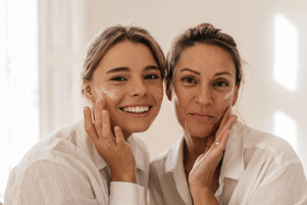
To build your ideal skincare routine, you need to know first which is your skin type:
- Oily
- Combination (oily T zone with other dry areas)
- Acne-prone
- Dry or sensitive
- Normal
And which skin concern do you want to tackle:
- Wrinkles and fine lines
- Acne
- Uneven skin tone
- Sensitive or dry skin
THE 3 SKINCARE ESSENTIALS
Regardless of your skin type or concern your skincare routine
ALWAYS
should include three basic steps to start with:
1.
Cleansing
2.
Moisturizing
3.
Sun protection
Let’s dive into each step to guide you on
how to choose
the perfect one for your
skin type
:
1.
CLEANSING

Washing your face is
always the first step
of any skincare routine. As a rule, a good cleanser will perform its function
without leaving your skin feeling dry, tight, and irritated
, so keep that in mind when trying your new product.
Choosing the right cleanser may depend on your skin type, but as a personal suggestion for any beginner, I would advise
starting with a mild/gentle cleanser
. To choose the perfect one for your needs, here is a general guideline:
SKIN TYPE |
CLEANSER FORMAT |
WHY? |
Oily/ Combination/ Acne-prone |
Light foaming cleanser or gel cleanser | Even if you have oily-prone skin, a gentle light foaming, or gel cleanser can remove the excess oil without stripping your skin of its natural oils.
Foam is not a synonym for efficacy; a cleanser can do its work without foaming. |
Dry/ Sensitive |
Cream/lotion cleanser | You want your skin to feel moisturized after a gentle cleansing step, to protect your skin barrier. |
Normal |
Gel cleanser or cream/lotion cleanser | Cleanse your face in a mild but effective way, leaving your skin feeling refreshed and moisturized. |
All skin types |
Micellar water or Oil cleanser |
Want to remove makeup? These are great alternatives as a first step of a “double cleansing” routine. After removing makeup, you can use the cleanser selected according to your skin type, to remove any residue of makeup or oil cleanser. |
2.
MOISTURIZING

Once you wash your face, the next step is to moisturize. Moisturizers increase skin hydration and help reduce trans-epidermal water loss by different mechanisms, improving the skin barrier, integrity, and appearance [2].
You can find 3 types of moisturizers in your products:
-
Humectants:
they provide hydration to the stratum corneum by attracting water from the skin’s deeper layers. Examples are glycerin, hyaluronic acid, panthenol, urea, propylene glycol, and sorbitol. -
Emollients:
they rebuild the lost lipids in your skin and smooth and preserve the skin barrier. Examples are vegetable oils, ceramides, cholesterol, and squalene. -
Occlusives:
they create a hydrophobic barrier on the skin surface able to prevent transepidermal water loss, sealing all moisture in. Examples are petrolatum, shea and cocoa butter, mineral oil, beeswax, lanolin, and dimethicone.
According to your skin type here is a guideline on how to choose the perfect product for you:
SKIN TYPE |
MOISTURIZER FORMAT |
WHY? |
Oily/ Combination/ Acne-prone |
Gel or Gel-cream | Gel-based products are formulated to avoid a “greasy” feel. Look for products rich in humectants. |
Dry |
Cream | Creams nourish your skin with different types of moisturizers. Look for thick creams rich in occlusives and emollients. |
Sensitive |
Lotions (“perfume free” and for “sensitive skin”) | Avoid perfumes, they can act as sensitizers. Look for lotions for “sensitive skin” with emollients (ceramides or squalane), humectants (glycerin, hyaluronic acid), and even calming extracts (aloe vera, oat, or chamomile). |
Normal |
Cream or lotion | They can provide emollients, humectants, and protective occlusives at the same time, to keep your skin functioning properly. |
3.
SUN PROTECTION
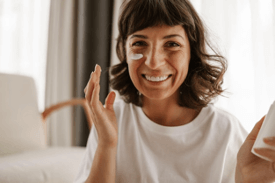
Sunscreens are an essential step in any morning routine. UV radiation is the worst enemy of your skin, responsible not only for the skin photoaging process but also for the development of skin cancer in the long run [3].
You must protect your skin every day with
sunscreen with a high SPF (30 or higher)
. To choose your ideal sunscreen follow the same guidelines described for moisturizers. You can choose a suitable moisturizer with SPF for your morning routine (2 in 1 application), meaning that you will need a second moisturizer for the night routine.
4.
ACTIVES TO TREAT YOUR SKIN CONCERN
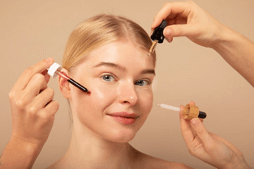
To this point, building a basic skincare routine using consistently your 3 essential products is more than enough.
However, if you want to treat a particular skin concern you can incorporate a serum into your night routine. A serum is a light water-based product intended to deliver high concentrations of active ingredients into your skin.
Here is a general guideline on how to choose an ideal serum for you:
SKIN CONCERN |
WHAT TO LOOK FOR |
Wrinkles and Fine lines |
Actives that help build collagen: peptides, vitamin C, niacinamide, retinol*, or AHAs* (Alfa Hydroxy Acids, like glycolic acid).
They can also contain antioxidants to help fight free radicals involved in skin aging. |
Acne |
Actives such as salicylic acid (also labeled as BHA), azelaic acid, niacinamide, or retinol*. |
Uneven skin tone |
Actives such as vitamin C, azelaic acid, niacinamide, retinol* or AHAs* (like kojic acid). |
Dry or Sensitive skin |
You can benefit from a simple hydrating serum with humectants and ceramides, and/or also look for products labeled as “calming”, “soothing” or “sensitive”. Avoid fragrances. |
CAUTION*:
- As a beginner, I would recommend you start with the other active ingredients, or with the lowest and most gentle concentration of Retinol or AHAs (get yourself informed first).
- Retinol and AHAs can never be applied together.
- Retinol and AHAs can produce irritation at the beginning, so you
can’t apply them every night
. Follow the guidelines on the label (normally you start with a very small amount every other night). - They make your skin sensitive to sunlight, so wash your face well the next morning and apply sunscreen.
NIGHT ROUTINE VS. MORNING ROUTINE
Now that you know how to select the building blocks to tailor your skincare routine, let’s see how you can combine them to build your Night and Morning routines.
Night routine.
Your night routine should follow this sequence:
1.
Cleanse:
essential to remove all makeup, excess oil, sweat, pollutants, dirt, and bacteria trapped in your face at the end of the day. You can benefit from “double cleansing” by first removing makeup with a micellar water or oil cleanser, and secondly washing your face and neck with your cleanser.
2.
Treat*:
apply on your face and neck the serum to treat your skin concerns.
3.
Moisturize:
after your serum absorbs, apply a generous amount of moisturizer to seal all actives and moisture into your skin (face and neck).
* If you are starting to apply Retinol or AHAs in your night routine:
only in this case can you apply the moisturizer first as a buffer, to reduce the irritation potential of these actives if they are not well tolerated by your skin.
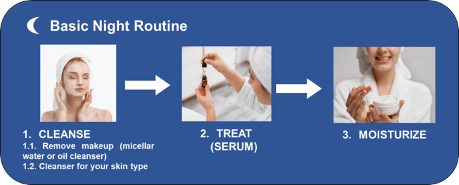
Morning routine.
The morning routine should follow this sequence:
1.
Wash your face (and neck)
completely with abundant water. The use of a cleanser may not be necessary, so it’s up to your skin’s needs.
2.
Moisturize
.
3.
Sun protection:
applying sunscreen (on the face and neck) should always be your top priority in the morning and the last step in your skincare routine.
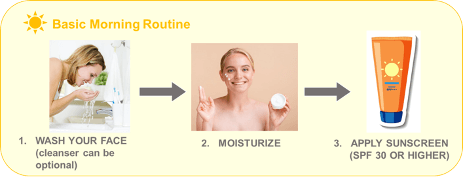
What about using a moisturizer with SPF (30 or higher)?
In this case, you can simplify your skincare routine to 1) washing and 2) Moisturizing (+SPF).
THE TAKEAWAY
An effective skincare routine doesn’t need to follow a long list of steps and products to actually work. Just a cleanser, a moisturizer, and sunscreen can do wonders for your skin, so keep it simple! Always tailor your skincare routine to make it work for your own needs and most importantly, give it time to see the real results. Remember, your skin is unique and so it must be your skincare routine.
REFERENCES
- Rodan, K., Fields, K., Majewski, G. P., & Falla, T. (2016). Skincare Bootcamp. Plastic and Reconstructive Surgery. Global Open, 4, e1152. https://doi.org/10.1097/gox.0000000000001152
- Purnamawati, S., Indrastuti, N., Danarti, R., & Saefudin, T. (2017). The Role of Moisturizers in Addressing Various Kinds of Dermatitis: A Review. Clinical Medicine & Research, 15 (3–4), 75–87. https://doi.org/10.3121/cmr.2017.1363
- Bosch, R. J., Philips, N., Suárez-Pérez, J. A., Juarranz, A., Devmurari, A., Chalensouk-Khaosaat, J., & González, S. (2015). Mechanisms of Photoaging and Cutaneous Photocarcinogenesis, and Photoprotective Strategies with Phytochemicals. Antioxidants, 4 (2), 248–268. https://doi.org/10.3390/antiox4020248

 By myulikeadmin
By myulikeadmin
